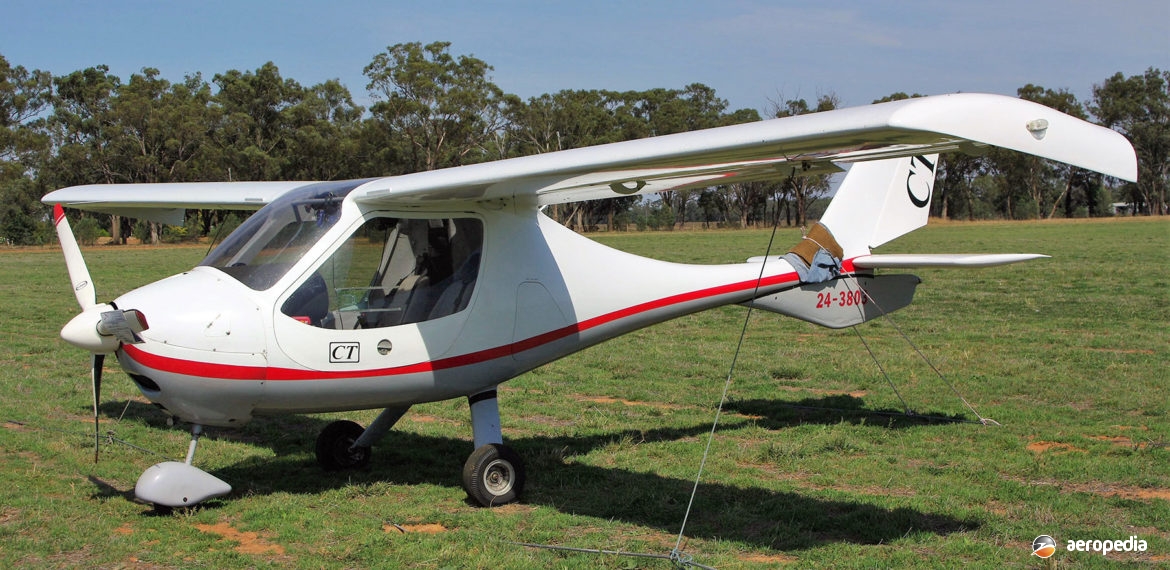Photograph:
Flight Design CT2K 24-3803 (c/n 01-09-02-36) at Temora, NSW in 2012 (David C Eyre)
Country of origin:
Czech Republic
Description:
Two-seat light sport, touring and training monoplane
Power Plant:
One 80 kw (100 hp) Rotax 912S four-cylinder, four-stroke, horizontally-opposed liquid-and-air-cooled engine
Specifications:
- Wingspan: 9.31 m (30 ft 6½ in)
- Length: 6.22 m (20 ft 5 in)
- Height: 2.165 m (7 ft 1¼ in)
- Wing area: 10.8 m² (116.30 sq ft)
- Max speed at sea level: 270 km/h (168 mph)
- Cruising speed at 75% power: 225 km/h (140mph)
- Stalling speed, clean: 74 km/h (46 mph)
- Stalling speed: 40 degrees flap 63 km/h (39mph)
- Service ceiling: 4,270 m (14,000 ft)
- Range at 148 km/h (92 mph) with max fuel and 30 mins
- reserve: 2,000 km (1,242 miles)
- Empty weight: 262 kg (578 lb)
- Loaded weight: 450 kg (992 lb); in some
countries 600 kg (1,322 lb)
History:
The Flight Design CT2K, initially known as the Pegasus CT2K, was one of a new breed of light aircraft being developed around the world to meet new regulations for light aircraft which could be operated under ultralight/microlight rules or could comply with normal registration requirements.
The CT2K was developed as an agile light machine with good visibility, a high cruising speed, and a long range. It was tested up to 600 kg (1,323 lb), production being initiated in 1997. Available only as a factory-built machine from Flight Design GmbH based at Echterdingen in Germany, it was constructed entirely from carbon fibre reinforced composite. Two baggage compartments were provided, each with a capacity of 25 kg (55 lb), and fuel capacity was 130 litres (28.5 Imp gals).
Power plant usually installed was the Rotax 912S providing 80 kw (100 hp) but the Jabiru 3300 unit of similar power was also available. In 2006 the type was shown at the Sun ‘n Fun Aerospace Expo in Lakeland, Florida, the United States distributor selling 70 aircraft in 2005, 45 being delivered that year.
The first example to be seen in this region was imported by CT Aviation Aircraft Importers in 2002, the first couple of aircraft being displayed at the Australian International Air Show at Avalon, VIC.
Production was four aircraft per week and reports indicated the Company had a backlog of nine months production. Examples have been exported to Italy, England, Spain, Scandinavia, South Africa, and some of the countries in the former Soviet Union.
In mid 2006 the Company announced, due to growing demand, it was going to increase the output of the carbon fibre fabrication facility in the Ukraine. Due to different certification criteria, the loaded weight of the aircraft varied from country to country: Germany being 472.5 kg (1,042 lb), Canada being 560 kg (1,235 lb) and Australia being 544 kg (1,199 lb).
New models have been introduced, including the CTSW which had wings 80 cm (31.5 in) shorter in span, this increasing the ground effect, providing better aerodynamic stability, being easier to land and having an increase in max speed by 5 km/h (3 mph) but having a slightly reduced rate of climb.
In mid 2006 a CTSW model was registered in Australia as VH-CTD (c/n 06-02-12), and a number have been registered under Recreational Aviation Australia (RAA) Regulations.
In 2007, to mark the 75th Anniversary of the Indian Air Force, two IAF officers in a CTSW in a period of 79 days completed a circumnavigation of the world, stopping in 19 countries.
In 2016 AeroJones Aviation of Taichung, Taiwan began to supply CTLS and CTLSi series under licence from the German manufacturer, Flight Design, to the American market, the aircraft being delivered to Flight Design USA for assembly and sale in South Woodstock, Connecticut. In 2018 representatives of the Taiwan company visited Australia and New Zealand looking for representatives to market the series of aircraft in the South Pacific.
In October 2018 Brumby Aircraft of Cowra, NSW, announced it had entered into an agreement with AeroJones to market and distribute the Flight Design range of sport aircraft throughout the Asia Pacific Region.
A Flight Design CTLS HB-WYB (c/n F-03-09-05) was flown by a crew of two disabled pilots, the aircraft being set-up for full hand controls with the logo of ‘Handicapped International’ on the tail. Accompanied by a Piper PA-24 Comanche HB-OVW support aircraft, in February and March 2019, the CTLS made a tour of Australia and New Zealand during a flight around the world commencing in Switzerland. Two CTLS aircraft initially were planned to carry out the flight, HB-WYA (c/n F-09-03-06) and HB-WYB but only the latter reached this part of the world. The former on approach to Bang Phra airport in the Racha near Bangkok, Thailand, hit power lines and crashed, killing the pilot and destroying the aircraft.

